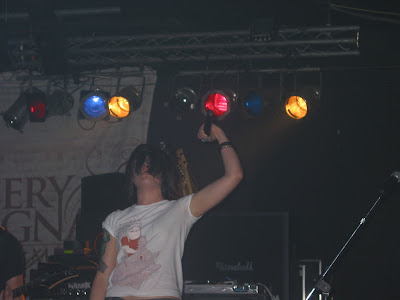Anyone who has ever tried to do photography on a more serious level knows about pictures that don’t quite make it. During my first photography class this evening the teacher told us that we would be lucky to get 3 or more good shots out of a box of film. I know how that goes. I guess it’s a good thing I’m digital because that could get a little expensive in terms of money and time.
But still, a failure in digital can be expensive, especially when you’re counting on at least a couple of shots coming through to the keeper pile. And even with all the great tools available for digital photography, not all photos can be saved. Sometimes we can come up with something passable, but still, for the most part, not usable.
The following pictures were taken with my Powershot G2 at the All That Remains concert here in Houston, TX on 26 January 2007. Now, the G2 is a prosumer camera and normally does pretty well, but I’ve found for concerts the limitations of the prosumer camera are quite… limiting. Admittedly, these were all taken on full auto before I started to understand the finer points of manual control…

This is a picture of Laura Nichol, vocalist for Light This City, with a fan at the show. The color is good and the preview looked awesome in the LCD window… but there was one problem. Notice how the fan’s metal salute is in focus? That was where the camera auto-focused itself and gave me a relatively shallow depth of field. The salute is crystal clear while the actual subjects are out of focus. The manual focus on a Powershot G2 is more trouble than it’s worth – it requires the live view LCD panel and then you only get a small area with which you see your focus point… you can’t tell how it affects the rest of the picture. This was disappointing to me as I thought I was going to have a definite keeper here.

Here is Laura on stage. This one fails because the whole thing is washed out. As this was taken in full auto, not even Aperture, Lightroom, or Photoshop will tell me what the ISO setting was for this photo. Given that this shot is for the most part clear, I decided to try something in Aperture…

I ended up with this picture. I dialed back the exposure, upped the contrast, and changed some saturation levels. For red, green, and dark blue I dialed back the saturation in order to make the stage lights behind her a little less prominent. I then upped the general saturation on the picture. The problem is, now, to me anyway, the light from one of the yellow stage lights looks unnatural. This picture may pass for an average fan’s collection, but commercially there is no way this is viable. I suppose it would be possible to do go balls-to-the-wall in Photoshop, but trying to rescue this in Photoshop would take a lot of time and skill that most people do not have.

Again, extremely washed out. The Powershot G2 does not have the most powerful of flashes and when it has to work against stage lights and be controlled by someone who doesn’t know what they’re doing… well, it makes for a bad day. This particular washout, however, was no worse then the rest of the pack… which leads me to believe there is another culprit to this failure… if you guess the blown out hand at the bottom, you guessed right (at least in my opinion). The flash isn’t the most powerful, and here I had something bouncing the light right back into the glass. I think this picture may have had a shot if not for the hand that got in the way.
Well, those are some of my failures. I have a lot more I can share, but I’ll leave those for another time. As such, I’ll leave you with a success from this past weekend:

Jason Wood of It Dies Today and Mercedes Lander of Kittie. Like most, I had a little bit of washout, so I dialed back the exposure and dialed up the saturations. They colors may look a little oversaturated at first glance. At that point however, there was a red light shining on them. The result was they looked, in real life, like they were saturated with color. I wanted to keep the picture as close as possible to what was being seen (which is subjective, but we do what we do) so I left the red levels alone. All in all, I don’t think this is a bad picture.
Aperture: f/5.6
Shutter Speed: 1/80 sec
Film Speed: ISO 1600 with 0ev
Focal Length: 50mm























